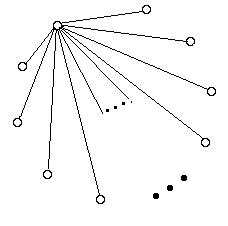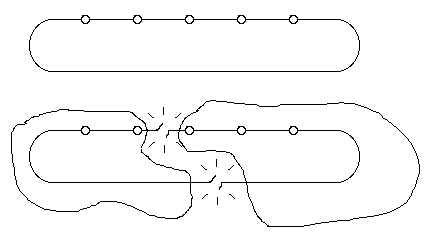LANs are great for the small areas they encompass, but other mechanisms must be used for wide area networks, such as the Internet. Imagine trying to detect collisions if the whole world were on one single Ethernet!
WANs, wide area networks, use a variety of network topologies, which are ways of arranging the connecting wires between the hosts of the network. If there are only two hosts, then a single wire between them is the only imaginable topology. When there are three, suddenly different possibilities begin to develop.
A fully connected network is one where each host on the network has a direct wire to every other host. This is okay for 2, 3, or even 4 hosts, but soon it begins to escalate. If there are N hosts, then the number of wires needed for a fully connected network is (N2-N)/2, which for all intents is N2, which is bad. If one more computer is added, N wires must be added. If the size of the network doubles, the number of wires goes up by 4. Fig. 23.11.1 shows fully connected networks of various sizes.
The calculation that leads to (N2-N)/2 is based on the fact that each node connects to N-1 other nodes (if there are N nodes.) Each node has this many wires coming out of it, so there are at least N(N-1) wires. However, a wire from A to B connects it the same as a wire from B to A, so only half of these wires are not redundant, leading to N(N-1)/2, which is (N2-N)/2. Theorists say that this function is approximately N2 because as N gets very large, the -N amount becomes insignificantly small. However, dividing N2 by 2 seems to drastically change the function, but for various theoretical reasons multiplication of a function by a constant doesn't change the function's broad behavior. Fig. 23.11.2 shows the arrangement of wires leading to (N2-N)/2.

Fig. 23.11.2: Fully connected networks in general
the total number of wires is almost N2
Ethernets and token rings give two other possible topologies. In an Ethernet, all hosts attach to the same wire, which is then called a bus (since it carries all of the signals and omnibus means everyone is Latin.)
Token rings are slightly more economical since there are N wires for N hosts. However, a break in one single wire can cause the other computers to have to redirect their signals to the other side, and the transit time for packets will increase. A single chain of hosts with wires between them is identical to a token ring with a broken wire, as shown in Fig. 23.11.3:
The diameter of a network is the longest route that any packet would have to take in traveling from one host to another. This route is measured in hops, or number of wires between hosts. In a broken token ring, the diameter is N-1, because in the worst case, the two computers at the ends of the chain would have to send packets through each wire in the chain to reach each other. In a bus, the diameter is 1 since there is only one wire between any two hosts.
If two wires go down in a token ring, then some hosts will no longer be able to talk to other hosts. We call this a partition of the network and it obviously is a very bad thing. However, hosts within each section of the network probably still can talk to others. Fig. 23.11.4 shows a token ring with two breaks causing a partition of size 2.

Fig. 23.11.4: Two breaks in a token ring cause a partition of the network
Partitions in a fully connected network are impossible unless every wire attached to a given host is broken.
Since fully connected networks are too expensive, some middle ground is sought where there are multiple paths between any two hosts in order to prevent partitions. The general term for this type of topology is mesh since it is like a mesh or net that traps things (fish, lint, debris, you name it.) Fig. 23.11.5 shows a mesh network. Every host has at least two connections to other hosts and some have more. We say that a mesh network gives higher connectivity than a simple chain or a token ring because each host connects to several other hosts in such a way that a partition is unlikely.
Most WANs are meshes of some type. The original ARPANET was a mesh. Today, the Internet consists of several meshes called backbones which have incredibly high speed telephone lines between them, often using satellite or radar transmission methods. The hosts in the backbones are not used for normal uses, but are specially devoted to forwarding traffic over the backbone. Hanging off each backbone host is another WAN that connects a variety of other WANs and LANs. End-user computers are found usually only on these LANs. Fig. 23.11.6 shows a hypothetical backbone with several LANs of various types hanging off it.
The Internet is an enormous hierarchy of networks, from a few high speed backbone WANs at the top, down through regional and national WANs, down to smaller WANs and finally to LANs. Only on the LANs are real end-user computers found.
The term internet refers to a collection of separate networks, whether they be WANs or LANs. Internetworking is the study of how to make these networks cooperate in order to provide a seamless image to all the attached hosts that there is but one huge network. This is not all that difficult when all the individual networks and hosts use the same protocols, such as TCP/IP, but if they use different protocol architectures, things get horribly complicated. For example, attaching an IBM SNA network to a DEC DNA network and both of those to the Internet is quite tricky and usually results in lowered performance or less than optimal connectivity. Some hosts may only be able to send mail, while others may be forced to convert all their packets from one form to another in order to send them across an intermediate network.
One last topology deserves to be mentioned since it historically was one of the first, though it suffers from many obvious problems. That is the star topology where one central computer, the hub, acts as the main switching center, accepting all incoming messages from the other hosts and rerouting them to the appropriate destination. Fig. 23.11.7 shows a star topology.
Obviously stars suffer from a vulnerability in the central hub which, if it dies, takes the whole network with it. Some early WANs were stars, such as CSNET which linked all the Computer Science Departments in academic institutions in the US for many years. Also, early mainframe and terminal networks were stars. A bus based topology is essentially a star if the hub is taken to be the coaxial cable instead of a distinct computer.